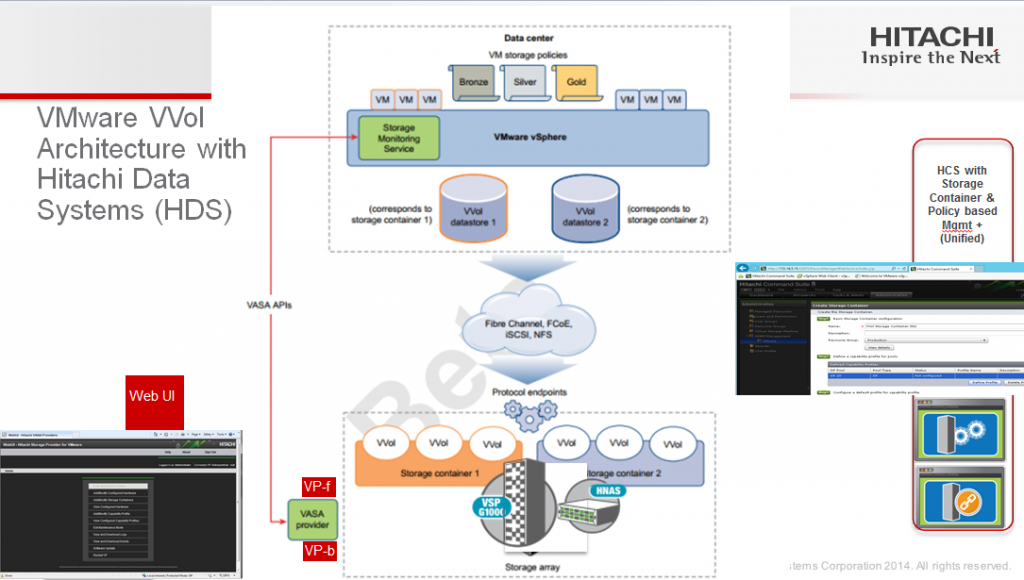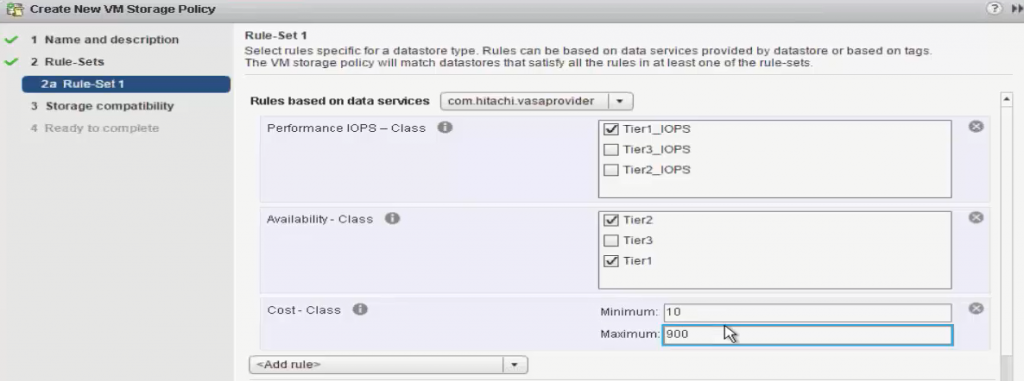It is my pleasure today to again offer a post that has been written by an esteemed industry colleague and guest blogger. This post on vVols was written by Hitachi Data System’s Dinesh Singh. Dinesh is Solutions Marketing Manager with Hitachi Data Systems focused on virtualization and cloud solutions. Dinesh drives awareness and adoption of HDS storage solutions for VMware Server and EUC virtualization platforms. In this post Dinesh tells us about how Hitachi has approached the implementation of Virtual Volumes on their platform, and gives us some very nice detail about what can be done with HDS gear when coupled with vVols.
—–
Finally the wait is over. Hitachi Data Systems recently announced the general availability of its integration with vSphere Virtual Volumes (vVols), enabling organizations to deploy Hitachi Storage infrastructure with vVols to bring customers on a reliable enterprise journey to a software-defined, policy-controlled data center.
A common question in our interactions with customers and partners has been how VM–centric management will be different from traditional NFS/VMFS datastores. vVols provides VM-level granularity to IT administrators by providing an abstraction layer in the form of storage API between control plane and storage systems. vVols framework allows SLO-driven application provisioning with the capability of providing a policy-based management approach per virtual machine for simplified IT operations.
In this initial release, we are enabling vVols and VASA support with the availability of new Hitachi virtual appliance software (delivered as OVA) plus supporting software release for our Hitachi NAS platform. We will also be making vVols integration available for Hitachi Virtual Storage Platform (VSP) G1000 in CQ2.
This has been quite the journey. HDS engaged with VMware as consultative partner in the early stages and invested significant engineering efforts to help our current and future customers realize the full benefits of robust, but simplified VASA and Virtual Volumes implementation. However, not all implementations are same as the devil lies in the details and that’s where HDS has led the charge.
HDS focus is to provide an enterprise level, trusted reliable zero worry implementation while empowering the storage administration and virtual infrastructure team with rich SPBM capabilities control. We are updating our HCS interface to provide that level of Enterprise SPBM capabilities whilst also providing a WebUI for VM admins, tailored for appliance management and entry SPBM. We are leveraging the vVols/SPBM framework to further elevate the rich data services that our customers enjoy today in VMware vSphere 5 environments be it with NFS or VMFS) such as Metro Storage Cluster with Global Active Device (GAD), automated data protection with Hitachi Virtual Infrastructure Integrator (V2I), plus the efficient data movement and snapshot/cloning offload technologies.

HDS storage-policy-based management allows automated provisioning of virtual machines (VM) and quicker adjustment to business changes. Virtual infrastructure (VI) administrators will have the capability to make changes to policies to reflect changes in business environment, dynamically matching storage-policy requirements for VMs to available storage pools and services.
In order to simplify IT management and better coordination between VM and storage administrators, Hitachi is delivering three categories of storage capabilities:
- Auto-generated capabilities (e.g. RAID type, encryption),
- Managed storage capabilities (e.g performance class, availability class, cost class)
- Custom capabilities (e.g. availability zone)
With the Hitachi implementation, the storage admin can now differentiate the resources both within the storage container and between storage containers based on the all-important performance, availability, cost and operational recovery class attributes. For example, They can now have storage resources which will only entertain VMs being provisioned on them that specifically request Tier 1 performance class and Tier 1 availability class (hence avoiding noisy or resource hog non-mission critical VM resources mistakenly being placed in the vicinity) or separately have storage resources that can support a minimum of Tier 2 performance class for other business essential apps. The cost class is a control valve that infrastructure teams can use to avoid the issue of business groups/tenants requesting Tier 1 performance for all their VMs when indeed lower cost class resources would indeed meet their business app performance needs. The snapshot backup class will be an interesting attribute capability for those familiar with Hitachi Virtual Infrastructure Integrator as we exploit that in coming releases.


Below is a screenshot of the interface within Hitachi Command Suite (HCS) dedicated to Storage Container/SPBM aspects. You (as part of storage or infrastructure team) can leverage this interface to define the capabilities on the individual storage resources within the storage container(s). In the example below, the storage admin has identified that his storage resource can advertise that it will support maximum of Tier 2 performance class and Tier 2 availability class , minimum cost of 500 etc. The system auto determines the other capabilities such as encryption and RAID level if VM admin wants to leverage in their VM storage policies.

Below is a screenshot of the vSphere web client where VM admins can create VM storage policies. In the example (pulled from the video below), the VM admin has decided to create a standard VM storage policy that all production Oracle databases for example being deployed must leverage this policy. The policy states that VMs get Tier 1 performance, and either Tier 1 or Tier 2 availability with no restriction in the cost of the storage resource being allocated.

In summary, HDS is implementing the vVols framework across file and block storage offerings. HDS is among the first storage provider to provide certified vVols support on its NFS platform (Hitachi NAS Platform). We will be making vVols integration available for Hitachi Virtual Storage Platform (VSP) G1000 in CQ2. The vVols framework can be surfaced on VSP G, Hitachi Unified Storage VM and Hitachi Unified Storage by deploying a Hitachi NAS controller (HNAS) as a gateway.
We look forward to working with customers and partners as we take advantage of this rich integration to bring customers on a zero worry robust reliable enterprise journey to software-defined, policy controlled data center.
Please check out www.hds.com/solutions/virtualization/vmware-vsphere/storage-solutions-for-vmware-virtualization/virtual-volumes.html for
- Business Benefits Video
- Technical Demonstration Video
- Joint webcast with VMware on HDS Integration with vVols
- Hitachi Storage with VMware vSphere vVols Technical implementation demo
- Comprehensive FAQ
- Download VASA Provider
For any questions, please write to [email protected] or post questions to HDS Server and Desktop Community site: https://community.hds.com/community/products-and-solutions/server
—–
Thanks once again to Dinesh for this informative post! Make sure to follow him @dineshsingh2004 -Ken



